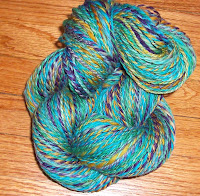Fair Isle mittens are funtional as well as warm, and beautiful.
Try using wooden needles instead of metal. Wooden needles are less slipery, the wooden needles will grip your stitches better.
You can bind off Fair Isle mittens with a 3 needle bind off from the inside.
The easiest way to knit Fair Isle mittens is to use 4 needles, and devide your stitches evenly onto 4 needles.
Using 5 DPN's will help to avoid ladders.
When choosing colors for your mittens, make sure that there's enough contrast between the background colors and the pattern color so the pattern doesn't get lost.
Carry the strands of unused color loosely in the back of the project.
If you carry the yarn, that is not in use to tightly, you will have puckers.
Loose stitches can be tightened, but it is almost impossible to loosen stitches that are to tight, and they will cause puckering on the right side of your project, and may even affect the fit.
To help you keep your place on the chart, use a magnetic board or a piece of sticky note paper to mark the row you're working, This makes it easier to follow the chart. You can move it up as you finish each row. The reason for placing the marker above the row you are working on, is so that you can see how it fits with with what you have already knit.
You can also make a working copy of your chart and inlarge it, so you can make your own personal notes on the pattern, this will alo help you follow along better.
The key to organizing your yarn, is to keep one ball on your right side, and the other color on your left side. You should hold the main color in which ever hand you feel the most comfortable.
Putting your ball of yarn in a bowl, so that it can roll around in the bowl, may prevent twisting of your yarn.
I like to use a ribbed cuff on my mittens, because the rib is more snug, and very elastic. Your ribbing can be shortened or lengthened, to make the mitten perfect for you.
If your mitten does not fit perfectly, washing and blocking the mitten can change the size. I always block my wool Folk mittens.
Felted wool is warmer, and more water repellent.













